The
Old Luggers online Academy of Marine Painting
The
Newfoundland Project -
Page Two
Return
to project First Page
 This page will be used
to develop and complete the painting. We'll make a few
more preliminary sketches and then maintain a commentary on what's happening at
each stage of the work - colours used, mixing notes etc. with as much self
criticism as we can stand and comments from you - whether we can stand them or
not -within reason!
This page will be used
to develop and complete the painting. We'll make a few
more preliminary sketches and then maintain a commentary on what's happening at
each stage of the work - colours used, mixing notes etc. with as much self
criticism as we can stand and comments from you - whether we can stand them or
not -within reason!
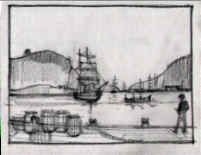 |
|
Left:
This is the sketch from lower right first page. The original
panorama has been cropped too much. Worse still I've squeezed the
elements to fit the space - the foreground figure is right on the margin
and Lurline has moved to the right losing the background of Signal Hill
we need for the light/dark counterchange. On balance this looks
more like a river than a bay. I'll make it a wider view. |
| Right:
The same view now widened. While 'Lurline' is still centre
left in the composition, we can now show her against Signal Hill - as
well as adding a small lugger off her starboard quarter. Our foreground
stevedore seems to have become Lloyds Agent - we'll settle his identity
later. We can also try out some colour ideas with watercolour and
chalk. |
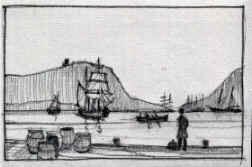
|
|
Here's our provisional
composition with an all-over golden ochre wash -looking much yellower
than I expected. However, this is only the underpainting
intended to unify the finished trial. With the local colours over
the top it should look better, and if it doesn't we can probably fiddle
with it electronically why not. |
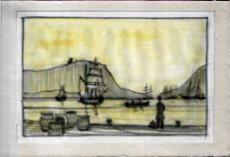 |
| Keen
to show late afternoon sun catching the hill tops I've underworked the
greens -making it look more like the Bay of Naples than St.Johns
Newfoundland. Also, my effort to smudge in a bit of mist has left
a hard line which appears as a distant ridge on the horizon! But the
light/dark values look about right. |
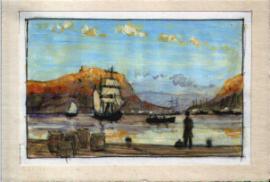
|
Colour
notes: This is just a trial but it makes sense to record what we
did. First we gave it an overall wash of golden ochre. The sky and
parts of the water are prussian blue - note the ochre showing through in
places. The hills are raw sienna brightened with cadmium yellow deep,
vermillion and white on the tops. Note that traces of all sky and land
colours are carried down into the water. Clouds and sails are raw sienna
with white. The 'blacks' are made with cobalt blue and burnt umber.
The mist is cobalt blue with alizarin crimson - well thinned with
matt medium or water or both.
Before
going for the final result I want to check some notes made earlier (below) about
Lurline's sail and general configuration on entering St.John's.
As I've never berthed anything without
engines larger than a 'Pirate' class dinghy, what is shown here is the product
of surmise and informed guesswork. But,
nothing daunted, our view of Lurline will show that the ship's boat has already
been launched to handle eventualities. This may involve taking heaving
lines ashore or even helping to pull on the bow or stern when aligning to the
berth. On the final approach fore-mast sails may be 'backed-up' (turned
into the wind) to cut or reduce the way.
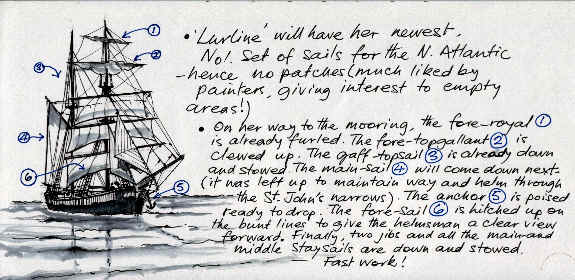
Good painting is most often about what we leave out rather
than put in but if we omit some detail for the sake of the picture the remaining
shapes must be true to their underlying detail - like drawing
people but not showing the bones.
Commenting on Lurline's final approach
to the dock, mariner and marine artist David Large (www.seadragon.com)
writes:
"Concerning
docking larger vessels, it has been my experience that the wind direction has a
great deal to do with how you approach a dock. Even with our Tuna Boats the wind
played a large part in docking. Mostly in the afternoon the wind is blowing on
shore because the land heats up, rises and draws cooler air from off of the
ocean ( this is assuming that there are no significant high or low fronts coming
in).
In your painting the vessel is heading towards the dock with the wind to
her port 1/4 stern, so the Captain would want to approach the dock with as
little sail as possible, only enough to keep good steerage. He also would
want to dock on the starboard side. There were times with our schooner
that there was sufficient wind that I could luff everything and let the wind on
the hull and rigging drift the boat into the dock.."
The trial picture shows the approach in fairly light airs but even
so there must be a case for reducing canvas - a sudden gust could wreak havoc at
this stage! I've said that I'll leave one good squares'l deployed which
can take way off the ship when brought up to wind.
So now to the finished effort . . . . .
|
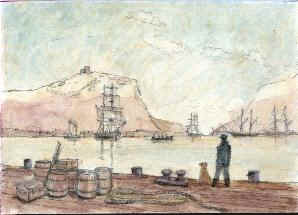
|
This is our
drawing for the finished painting - suitably tinted to banish blank
canvas syndrome and also to establish light and dark areas as they
will occur - but probably with a fair bit of adjustment. |
In the trial run I was dismayed by how yellow it looked using
the golden ochre but for this version I've gone back to the trusted raw sienna
for staining the board. I'm using board cut to the size of my scanner by the
way. The other colours are burnt umber, prussian blue and the smallest
drop of deep violet - all applied with glaze medium. The general idea is
to produce a period feel to the picture hopefully to make it seem contemporary
with the event it depicts. I think modern retrospects of past events
created with modern techniques often fail to produce the 4th dimension of deep
time -I hope that makes sense.
"Arrival
in St.John's"
Acrylic
295mm X 210mm
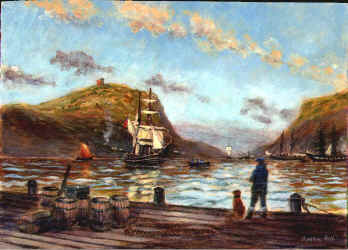
Click the picture to see a
'brushstrokes' enlargement.
The rash
decision to paint this to fit my scanner had me struggling with the skills of
the miniaturist - edges of razor blades, mapping pens and the fabled one-haired
sable brush - I usually work 20 ins x 30ins.
The first job
under the rough heading 'composition' could be to spot the differences with the
sketch. Firstly the 'Lurline' looked too far left in the sketch and was
also too small to have any hope of developing interesting detail and more
importantly would not show up to best advantage against the bulk of Signal
Hill. Advancing the ship on her course would have the dual result of
moving her to the right and bringing her nearer. It worked out reasonably
well. The large mooring bollard in the foreground (sketch) was a bit too
obvious even for a 'Victorian' narrative painting so it went. The
foreground figure was a bit off ballance. By folding his arms, posture was
restored and the effect of a descending evening chill was enhanced aided by a
raised collar and wood smoke rising from a homestead across the bay. I did
promise to settle the identity of this figure. Lets say he's the Assistant
Harbour Master walking the Harbour Master's dog. Other elements: another
vessel is entering the narrows, this establishes distance and perspective. It
also gives an idea of movement - where our ship was then and where it is now
and the route it has taken - pseudo-animation as I called it
elsewhere. Off to the right are a trading schooner and an ex-naval brig
refitting. In general the composition has four main areas which we can
examine separately: Sky, Background, Midground and Foreground. Lighting
will be a topic on its own.
Sky : The
sky is painted in prussian blue lightening into turquoise toward the
horizon. The area of sea mist is from violet, cobalt blue and burnt umber
worked into a thin glaze with gloss medium. Two bands of cloud cross the
sky, the top well lit one is in white with added raw sienna and high lighted
with small additions of cadmium yellow and vermillion and shadowed with the sea
mist mixture. The unlit clouds are scrubbed in with a bristle brush also
using the sea mist colour.
Background:
The heights are worked with raw sienna on its own and mixed with cobalt blue for
the greens and cobalt blue with cadmium yellow for brighter greens. Shadowing
and modelling are achieved with burnt umber, blue and violet mainly in gloss
medium glazes overlaying raw sienna - to maintain a bit of radiance through
the gloom. The sea mist beginning to form at the base of the heights along
the waterline is from white and coereleum blue in a thin glaze - this helps
to provide a counterchange for the detail painted against it.
Midground:
Black hulls are from burnt umber and cobalt blue. The sea colours are as
for the sky and land but grayed down a bit for the colour lost in reflection.
Foreground:
The boardwalk quayside uses thin glazes one over the other of colours used
throughout the picture but aiming to give the effect of grained weathered lumber
ie. finishing off with added white in some places but trying not to kill it! I'm
only moderately pleased with my own effort.
LIGHTING:
(note capital letters!) There is a preference in some quarters of
modern painting to paint against the light. This puts elements of your picture
in partial silhouette against the light, clearly perpendicular to the
ground and nicely outlined by halos of light leaking from the lit but
unseen face. This picture is 180 degrees different with full low level sun
on the focus of interest - so that it will be well refelected in the water.
Being a low level sun, areas of the picture can be in shade to produce bold
contrasts with the objects in front of them. The foreground is in shade as in a
theatre on the auditorium side of the footlights, introducing we hope a
strong observer-identification effect. The tops of the barrels (salt
cod for Oporto) are slightly lit to enhance their uprightness.
That's really
all I should say. I hope this might give ideas for your own project. Let me know how you
make out and if the work is compatible with what we're trying to achieve here we
can make a link to it. E-mail: signals @oldluggers.co.uk
Return
to Newfoundland Project First Page
Return to the Old
Luggers Home Page

 This page will be used
to develop and complete the painting. We'll make a few
more preliminary sketches and then maintain a commentary on what's happening at
each stage of the work - colours used, mixing notes etc. with as much self
criticism as we can stand and comments from you - whether we can stand them or
not -within reason!
This page will be used
to develop and complete the painting. We'll make a few
more preliminary sketches and then maintain a commentary on what's happening at
each stage of the work - colours used, mixing notes etc. with as much self
criticism as we can stand and comments from you - whether we can stand them or
not -within reason! 



